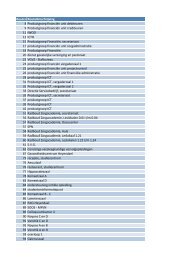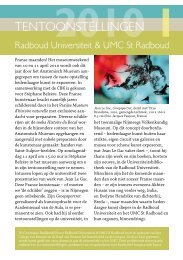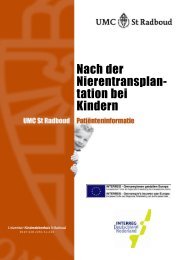FACTSHEET: GENDER AND DEPRESSION
FACTSHEET: GENDER AND DEPRESSION
FACTSHEET: GENDER AND DEPRESSION
Create successful ePaper yourself
Turn your PDF publications into a flip-book with our unique Google optimized e-Paper software.
Update: 31-05-2011<br />
<strong>FACTSHEET</strong>: <strong>GENDER</strong> <strong>AND</strong> <strong>DEPRESSION</strong><br />
Epidemiology<br />
• In adults and the elderly, depression is two times more prevalent in<br />
women than in men: 10%-25% of women are at risk of developing<br />
depression in the course of their lives, as against 5%-12% of men.<br />
(Nationaal Kompas Volksgezondheid (RIVM and Goldstein).<br />
• In young people between the ages of 13-17, depression is three times<br />
more prevalent in girls than in boys (Nationaal Kompas Volksgezondheid<br />
(RIVM))<br />
Risk Factors<br />
Individual Susceptibility<br />
• Women with physical, emotional, and sexual abuse in their medical<br />
history and women with current or past violence in their partner<br />
relationship are at much greater risk of developing depression (Hegarty);<br />
37%-41% of women visiting their GP have experienced intimate partner<br />
violence at some point (Lo Fo Wong).<br />
• Relationship issues and problems with children are risk factors for<br />
depression in women more than in men, with the lack of a supportive<br />
network of significant relations providing an additional risk (Accortt,<br />
Buis, Bromberger, and Nicolai).<br />
Social Factors<br />
• People with low Socio-Economic Status (SES) are more at risk of developing<br />
depression than people with greater economic success. Women are exposed<br />
to chronic stressors such as low income, crime, violence, their children’s<br />
illnesses, and assaults more than men (Bromberger). At-risk groups for<br />
depression are: low-SES single mothers; working mothers in low-grade<br />
positions; single elderly women lacking a social support network (Möller-<br />
Leimkühler).<br />
Hormonal Factors<br />
• In approximately 5% of women, hormonal imbalances during the fertile<br />
period cause PMDD, the serious variant of PMS (Accort and Thorpe).<br />
• During menopause, women who have experienced depression<br />
before are more vulnerable to developing depression once again<br />
(Noble).<br />
• Twenty per cent of pregnant women develop symptoms of depression, with<br />
one in ten developing genuine depression (Yonkers).<br />
• Ten to fifteen per cent of women develop postnatal depression<br />
(Kornstein). Women who have had postnatal depression before are at<br />
25% risk of developing such a depression once again (Marcus).<br />
1<br />
Bent u op zoek naar onderwijsmateriaal, of wilt u meer informatie over hoe u uw onderwijs<br />
sekse- en cultuur specifiek kunt maken? Kijk dan op onze website: www.umcn.nl/ksdmo of<br />
neem contact op per e-mail: ksdmo@elg.umcn.nl
Update: 31-05-2011<br />
Gender Roles<br />
• Women are at greater risk of getting depressed because they<br />
value intimate relationships (Accortt).<br />
• Girls have a negative body image more often than boys (Seiffge-Krenke).<br />
• Men identify physical diseases, problems at work, and unemployment as<br />
causes of depression more often than women (Angst).<br />
• Single men or men who survive their partners are particularly vulnerable for<br />
• depression; women appear to be more resilient later in life when they<br />
have been widowed or live alone (Goldstein).<br />
• Widowers are more at risk of depression than widows. Widowers who rely<br />
heavily on their children are especially at risk. Widows tend to have a more<br />
extensive social network involving relatives, neighbours, and friends<br />
(Stevens).<br />
Co-morbidity<br />
• Insomnia and depression often go together and occur in conjunction more<br />
in women than in men (Krystal).<br />
• Depression causes a sharp increase in cardiovascular diseases in women,<br />
and cardiovascular diseases cause more severe depression in women than<br />
in men (Möller- Leimkühler).<br />
Presentation and Diagnostics<br />
• In men, depression is more often masked by use of alcohol and drugs or<br />
compulsive- obsessive behaviour than in women (Orengo).<br />
• In women, anxiety and panic disorders and eating disorders make<br />
diagnosing depression more difficult (Have). In women, the<br />
combination of anxiety and depression is twice as prevalent as in<br />
men (Zender).<br />
• More men (52%) avoid help-seeking than women (41%) (Angst). Men<br />
are less inclined to report depressive symptoms or seek professional<br />
help than women (Orengo).<br />
• Many men who are depressed are not identified as such and are not<br />
treated. This may be related to a male gender role that fosters an attitude<br />
of stoicism and suppressed emotion (Accortt).<br />
Coping<br />
• Men tend to avoid feelings of not being in control by rationalizing or<br />
denying them (Kilmartin). When they are depressed, men tend to look for<br />
external causes outside their sphere of influence, whereas women tend to<br />
blame themselves (Cochran, Have, and Buis). Women lack a task- or<br />
action-oriented approach to stressful situations, which may cause<br />
depression (Bromberger). Men more often tend to take their mind off<br />
things by engaging in sports (Angst).<br />
2<br />
Bent u op zoek naar onderwijsmateriaal, of wilt u meer informatie over hoe u uw onderwijs<br />
sekse- en cultuur specifiek kunt maken? Kijk dan op onze website: www.umcn.nl/ksdmo of<br />
neem contact op per e-mail: ksdmo@elg.umcn.nl
Update: 31-05-2011<br />
• Boys develop more effective coping strategies to negative events<br />
in their lives than girls. Boys take their mind off things in stressful<br />
situations; girls and women tend to go for a more brooding coping style<br />
and appear to be more self-focused in stressful situations (Accortt,<br />
Bromberger, and Seiffge-Krenke).<br />
Disease Course<br />
• Although depressed women make more suicide attempts than men, the<br />
number of successful suicides is four times higher in men than in<br />
women (Orengo).<br />
• Suicide accounts for 20% of post-partum deaths (Lindahl).<br />
Consequences<br />
• Women feel the effects of depression in quality of sleep and general health<br />
more than men (Angst).<br />
• Depressed men are affected by their reduced capacity for work more than<br />
women (Angst).<br />
Literature<br />
• Accortt, E. E., M. P. Freeman, and J. J. Allen, "Women and major depressive disorder:<br />
• clinical perspectives on causal pathways," J.Womens Health (Larchmt.) 17 (10): 1583-<br />
• 1590 (2008).<br />
• Angst, J. et al., "Gender differences in depression. Epidemiological findings from the<br />
• European DEPRES I and II studies," Eur.Arch.Psychiatry Clin.Neurosci. 252 (5): 201-<br />
• 209 (2002).<br />
• Bromberger, J. T., "A psychosocial understanding of depression in women: for the primary<br />
care physician," J.Am.Med.Womens Assoc. 59 (3): 198-206 (2004).<br />
• Buis, W., “Depressie”, in: Sekseverschillen in ziekte en gezondheid. Lagro-Janssen, T. en<br />
• G. Noordenbos (red.), SUN: Nijmegen (1997).<br />
• Cochran, S.V. and F.E. Rabinowitz, Men and depression: clinical and empirical<br />
perspectives. San Diego: Academic Press, 2000<br />
• Goldstein, R. D. and A. M. Gruenberg, "Major Depressive Disorder in the older adult:<br />
• implications for women," J.Women Aging 19 (1-2): 63-77 (2007).<br />
• Have, M. ten, C. Schoemaker, en W. Vollebergh, “Genderverschillen in psychische<br />
stoornissen, consequenties en zorggebruik. Resultaten van de Netherlands Mental Health<br />
Survey and Incidence Study (NEMESIS),” Tijdschrift voor Psychiatrie 44 (6): 367-375<br />
(2002).<br />
• Hegarty, K. et al., "Association between depression and abuse by partners of women<br />
attending general practice: descriptive, cross sectional survey," BMJ 328 (7440): 621-624<br />
(2004).<br />
• Kilmartin C., “ Depression in men: communication, diagnosis and therapy”. J Men’s Health<br />
2:96-99 (2005).<br />
• Kornstein, S. G., "The evaluation and management of depression in women across the life<br />
span," J.Clin.Psychiatry 62 Suppl 24: 11-17 (2001).<br />
• Krystal, A. D., "Depression and insomnia in women," Clin.Cornerstone. 6 Suppl 1B: S19-<br />
S28 (2004).<br />
3<br />
Bent u op zoek naar onderwijsmateriaal, of wilt u meer informatie over hoe u uw onderwijs<br />
sekse- en cultuur specifiek kunt maken? Kijk dan op onze website: www.umcn.nl/ksdmo of<br />
neem contact op per e-mail: ksdmo@elg.umcn.nl
Update: 31-05-2011<br />
• Lindahl, V., J. L. Pearson, and L. Colpe, "Prevalence of suicidality during<br />
pregnancy and the postpartum," Arch.Womens Ment.Health 8 (2): 77-87<br />
(2005).<br />
• Lo Fo Wong, S., F. Wester, S.S.L. Mol and T.L.M. Lagro-Janssen, “Increased<br />
awareness of intimate partner abuse after training: a randomized controlled trial”. British<br />
Journal of General Practice 56(525):249-57 (2006).<br />
• Marcus, S. M. and J. E. Heringhausen, "Depression in childbearing women: when<br />
depression complicates pregnancy," Prim.Care 36 (1): 151-65, ix (2009).<br />
• Möller-Leimkühler, A. M., "Gender differences in cardiovascular disease and comorbid<br />
depression," Dialogues.Clin.Neurosci. 9 (1): 71-83 (2007).<br />
• Nationaal Kompas Volksgezondheid (RIVM) – geraadpleegd: 28 jan. 2010. URL:<br />
• http://www.rivm.nl/vtv/object_class/kom_depressie.html<br />
• Nicolai, N. Vrouwenhulpverlening & psychiatrie. Babylon-De Geus: Amsterdam, 1997<br />
• Noble, R. E., "Depression in women," Metabolism 54 (5 Suppl 1): 49-52 (2005). Orengo, C.<br />
A., G. Fullerton, and R. Tan, "Male depression: a review of gender concerns and<br />
testosterone therapy," Geriatrics 59 (10): 24-30 (2004).<br />
• Seiffge-Krenke, I., "[Depression in children and adolescents: prevalence, diagnosis,<br />
etiology, gender differences and therapeutic approaches],"<br />
Prax.Kinderpsychol.Kinderpsychiatr. 56 (3): 185-205 (2007).<br />
• Stevens, N., “Gender and adaptation to widowhood in later life.” Ageing Society 15:37-58<br />
(1995).<br />
• Thorpe, L. et al., "Clinical guidelines for the treatment of depressive disorders. VI. Special<br />
populations," Can.J.Psychiatry 46 Suppl 1: 63S-76S (2001).<br />
• Yonkers, K. A., "Special issues related to the treatment of depression in women,"<br />
• J.Clin.Psychiatry 64 Suppl 18: 8-13 (2003).<br />
• Zender, R. and E. Olshansky, "Women's mental health: depression and anxiety,"<br />
• Nurs.Clin.North Am. 44 (3): 355-364 (2009).<br />
4<br />
Bent u op zoek naar onderwijsmateriaal, of wilt u meer informatie over hoe u uw onderwijs<br />
sekse- en cultuur specifiek kunt maken? Kijk dan op onze website: www.umcn.nl/ksdmo of<br />
neem contact op per e-mail: ksdmo@elg.umcn.nl
















